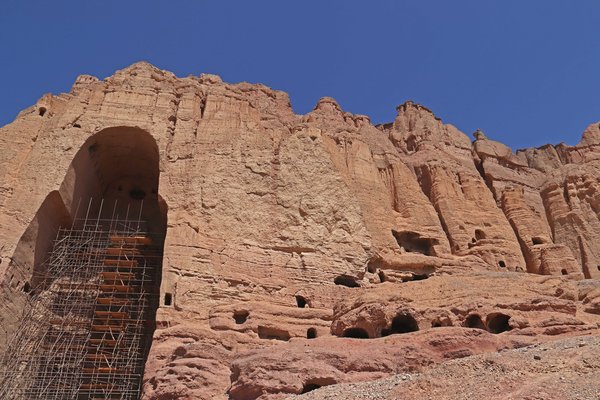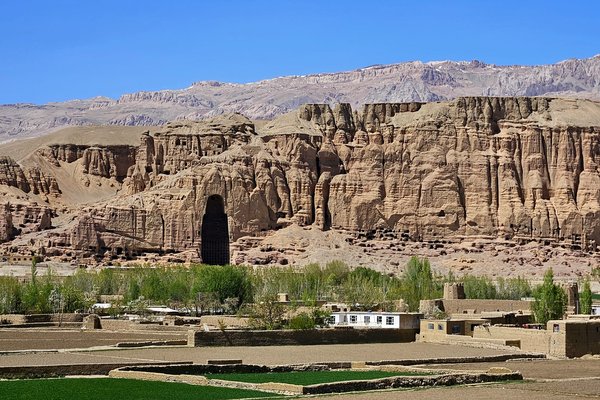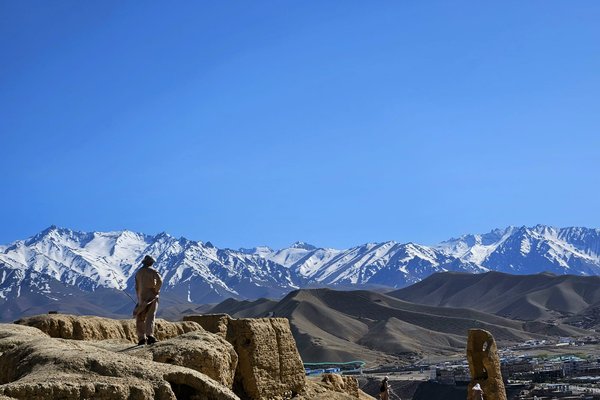Afghanistan
Bamiyan Valley
The Cultural Landscape and Archaeological Remains of the Bamiyan Valley are an outstanding representation of Gandharan Buddhist art and culture in Central Asia.
The kingdom of Bamiyan was a Buddhist state strategically located on the Silk Road and an important pilgrimage center. The site has eight components, including caves with painted decorations and Buddha statues carved into the cliffs. The cliffs held two standing Buddhas, measuring 55 and 37 meters high respectively, that were the largest examples of standing Buddha carvings in the world. They were deliberately destroyed in March 2001 by the Afghan Taliban government and only the niches remain.
Community Perspective: Sidney visited in 1971 and witnessed a spectacular sunset on the Buddha statues. Wojciech has described the situation he found in 2024, when he saw the now-empty niches and two further components.
Site Info
Official Information
- Full Name
- Cultural Landscape and Archaeological Remains of the Bamiyan Valley (ID: 208)
- Country
- Afghanistan
- Status
-
Inscribed 2003
Site history
History of Bamiyan Valley
- 2003: In Danger
- "suffered from abandonment, military action and dynamite explosions. Parts of the site are inaccessible due to the presence of antipersonnel mines."
- 2003: Inscribed
- Inscribed
- 1983: Deferred
- Deferred as conditions under which recommendation made not yet fulfilled
- In Danger
- "suffered from abandonment, military action and dynamite explosions. Parts of the site are inaccessible due to the presence of antipersonnel mines." Since 2003
- Type
- Cultural
- Criteria
- i
- ii
- iii
- iv
- vi
Links
- UNESCO
- whc.unesco.org
- Official
-
- bamiyanculturalcentre.org — Visit Bamiyan
- Related
-
- news.bbc.co.uk — Link
All Links
UNESCO.org
- whc.unesco.org — whc.unesco.org/
Official Website
- bamiyanculturalcentre.org — Visit Bamiyan
Related Resources
- news.bbc.co.uk — Link
News Article
- April 22, 2023 theartnewspaper.com — Italy throws Afghanistan a lifeline for restoration in the Bamiyan area
- April 27, 2022 theartnewspaper.com — Taliban orders coal traders to leave Afghanistan's Bamiyan Valley
- Feb. 9, 2022 news.artnet.com — A Rogue Taliban Governor Has Been Digging Beneath the Ruins of the Bamiyan Buddhas, Chasing a Rumor of Buried Treasure
- Nov. 25, 2021 cnbc.com — The Taliban destroyed Afghanistan’s ancient Buddha statues. Now they’re welcoming tourists.
- Nov. 11, 2021 gandhara.rferl.org — Video Shows Taliban Using Remnants Of Bamiyan Buddhas For Target Practice
- Sept. 14, 2021 english.kyodonews.net — Bamiyan artifacts pillaged amid Afghan turmoil
- Feb. 27, 2020 menafn.com — Preparing the Removal of Bamiyan from the List of World Heritage in Danger
- July 30, 2018 www3.nhk.or.jp — Afghanistan shelves plan to restore Bamiyan Buddha
- Jan. 25, 2018 gandhara.rferl.org — Official Warns Of Vanishing Archeological Sites In Bamiyan Valley
- Dec. 1, 2016 dailymail.co.uk — Rebuilding history? Debate rages over lost Afghan Buddhas
- June 15, 2015 theatlantic.com — Bamiyan Buddhas rise again in 3D
- Feb. 9, 2014 khaama.com — Bamiyan Buddhas unauthorized reconstruction work stopped
- Feb. 18, 2012 thehindu.com — Destroyed Bamiyan Buddha statues not to be rebuilt
- March 18, 2011 ipsnews.net — Ancient Buddhas Will Not Be Rebuilt - UNESCO
- May 5, 2008 nzherald.co.nz — UN says remaining Bamiyan Buddha statues did not suffer from blast by NZ soldiers
- Dec. 10, 2006 sfgate.com — World ponders rebuilding biggest Buddhas
- July 26, 2006 news.yahoo.com — Ancient Persian drawing found in Afghan Buddhist cave
Community Information
- Community Category
- Religious structure: Buddhist
- Cultural Landscape: Relict
Travel Information
One thousand visitors or fewer
Red Zone Travel Advisory
Recent Connections
-
Ella Maillart
Visited in 1939. Captured in the film …
-
Named after a River
"The Kunduz River (Persian: رود قندوز) … -
Red Zone Travel Advisory
Afghanistan fully off-limits
Connections of Bamiyan Valley
- Individual People
-
-
William Moorcroft
"Moorcroft continued his journey, reaching Kashmir on 3 November 1822, Jalalabad on 4 June 1824, and Kabul on 20 June. He and his companions were the first Europeans to see the Buddhas of Bamiyan" (Wiki). In fact the Hungarian pholologist, orientalist and founder of Tibetology", Sándor Kőrösi Csoma had done so around Jan 1822 and had subsequently met up with Moorcroft in Kashmir in July 1822. -
Xuanzang
In Bamyan, Xuanzang met the king and saw tens of non-Mahayana monasteries, in addition to the two large Buddhas of Bamiyan carved out of the rockface. -
Travels of Hyecho
"A month later, Hyeocho arrives in Gandhara, where Buddhist art reached brilliant heights. He goes north from there, passing through Oddiyana, and then west, to Afghanistan. He visits Bamyan and then heads to Tokhara." - Northeast Asian History Foundation -
Genghis Khan
The Shahr-e Gholghola was the site of 13th century Siege of Bamyan and the massacre of the city's population by Mongol conqueror Genghis Khan, avenging the murder of his favorite grandson. This is the origin of the city's moniker "City of Woe". The citadel of Shahr-e Zuhak in the valley was also destroyed by Genghis Khan.See en.wikipedia.org
-
Ella Maillart
Visited in 1939. Captured in the film documentary "Double Journey" (2015) . https://www.swissfilms.ch/fr/movie/ella-maillart-double-journey/6cd0a60f678b4b6489437807dd896bfd
-
- Geography
-
-
Highest cultural WHS
2,800 m
-
- Trivia
-
-
In Video Games
Call of Duty: Black Ops II -
Built elsewhere as a full size replica
n Sri Lanka, a full-scale replica of one of the Buddhas has been created which is now known as the Tsunami Honganji Viharaya at Pareliya. It is dedicated to the victims of the 2005 tsunami.See en.wikipedia.org
-
- History
-
-
Silk Roads
Southern Land Route; "stopping place on the branch of the Silk Route, which linked China and India via ancient Bactria; ... an important Buddhist centre on the Silk Road" (AB ev)See en.unesco.org
-
Sassanid Empire
The two Buddhas were built in the period between AD 544 to 595 for the 38 meter "Eastern Buddha" and between AD 591 and 644 for the larger "Western Buddha". In this period, Bamiyan was part of the Sassanid Empire. The Gandhara school of Buddhist art, of which Bamiyan Valley is an outstanding representation, drew from the Hellenistic, Roman and Sasanian art traditions. In the Kakrak Valley caves, there are fragments remaining of a sanctuary with painted decorations from the Sasanian period. (AB ev) -
Sieges and Battles
The Shahr-e Gholghola was the site of 13th century Siege of Bamyan and the massacre of the city's population by Mongol conqueror Genghis Khan, avenging the murder of his favorite grandson. This is the origin of the city's moniker "City of Woe".See en.wikipedia.org
-
- Architecture
-
-
Stand-alone Rock Reliefs
Two monumental Buddhist statues carved out of a cliff -
Cave dwellings
"The valley was abandoned for a long period, but at the end of the 19th century, the caves were inhabited and used as shelters for domestic animals." (AB evaluation) -
Greco-Buddhist Art
"The statues represented a later evolution of the classic blended style of Greco-Buddhist art at Gandhara" (wiki)See en.wikipedia.org
-
- Damaged
-
-
Landmines
See www.unhcr.org
-
Blown up
Bamiyan buddhas, 2001 -
Iconoclasm
Buddhas destroyed by the Taliban in 2001
-
- World Heritage Process
-
-
Directly in Danger
2001 Buddha statues destroyed, 2003 inscribed and placed in danger -
Ten years or more to inscribe
1983-2003
-
- Religion and Belief
-
-
Buddhist sites in non-Buddhist countries
-
Legends and Folk Myths
Legend has it that the two statues are two runaway lovers who petrified themselves to remain frozen together in eternity.
-
- Constructions
-
-
Cultural sites connected to Cliffs
Bamiyan Buddha built into the cliff -
Giant Buddha statues
The two most prominent statues were the giant standing Buddhas Vairocana and Sakyamuni, identified by the different mudras performed, measuring 55 and 37 metres (wiki)
-
- WHS on Other Lists
-
-
World Monuments Watch (past)
Buddhist Remains of Bamiyan (2008)
-
- Timeline
-
-
Built in the 6th century
Following the destruction of the statues in 2001, carbon dating of organic internal structural components found in the rubble has determined that the two Buddhas were built circa AD 600, with narrow dates of between AD 544 to 595 for the 38 meter "Eastern Buddha", and between AD 591 and 644 for the larger "Western Buddha".See en.wikipedia.org
-
- Science and Technology
-
-
Digitized by Iconem
-
Cultural property cloning
"the painting of the “Soaring god of the sun” that was present on the ceiling of the Buddhas in Bamiyan in Afghanistan, which was destroyed in 2001"
-
- Visiting conditions
-
-
One thousand visitors or fewer
DD : “There are no statistics available on the number of visitors and tourism activities. As Afghanistan has suffered many years of civil unrest in the past two decades, tourism development has been scarce in recent years.” (there may be a reasonable number of local visitors) -
Red Zone Travel Advisory
Afghanistan fully off-limits
-
- WHS Names
-
-
Named after a River
"The Kunduz River (Persian: رود قندوز) is a tributary of the Amu Darya in northern Afghanistan. It rises in Bamyan Province in the Hindu Kush, and in its upper reaches is also known as the Bamyan River or the Surkhab River" (wiki)
-
News
- theartnewspaper.com 04/22/2023
- Italy throws Afghanistan a lifelin…
- theartnewspaper.com 04/27/2022
- Taliban orders coal traders to lea…
- news.artnet.com 02/09/2022
- A Rogue Taliban Governor Has Been …
Community Reviews
Show full reviews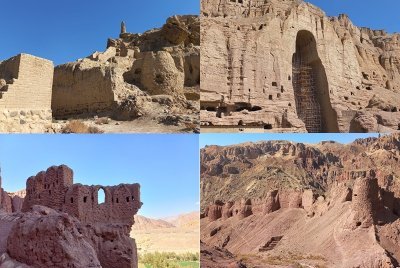
I visited the monuments of Bamyan during one day in September 2024. For an appetizer, there was Shahr-i Ghulghulah, which can be translated as the City of Screams. This rather terrifying name comes from the destruction of the city by Genghis Khan's troops, which left no one alive. Apparently this was because Genghis Khan's beloved grandson had been killed earlier during the siege of Bamyan, but the Mongols did not need too many excuses to destroy everything living among their defeated opponents. The City of Screams never recovered from this massacre and today it is a complex of charming ruins on the mountainside.
The main course was something that doesn't exist. The world's largest standing Buddha statues, carved into rocks in the 6th century AD. and barbarously destroyed by the Taliban during their first rule in 2001. Despite several attempts and the scaffolding existing for unknown reasons, these statues have not been recreated, only niches remain. They can be viewed from below and above, because a system of corridors led to the head of each statue. Currently, the corridors located next to the smaller, 37-meter statue are open. Visiting the niches is more of an exercise in the imagination, because without the statues they are much less interesting. As a side note - it seems that the current Taliban are more liberal for now, but in my opinion this is just an illusion. After consolidating their power, they may return to the barbaric practices known from 1996-2001.
… Keep reading 0 comments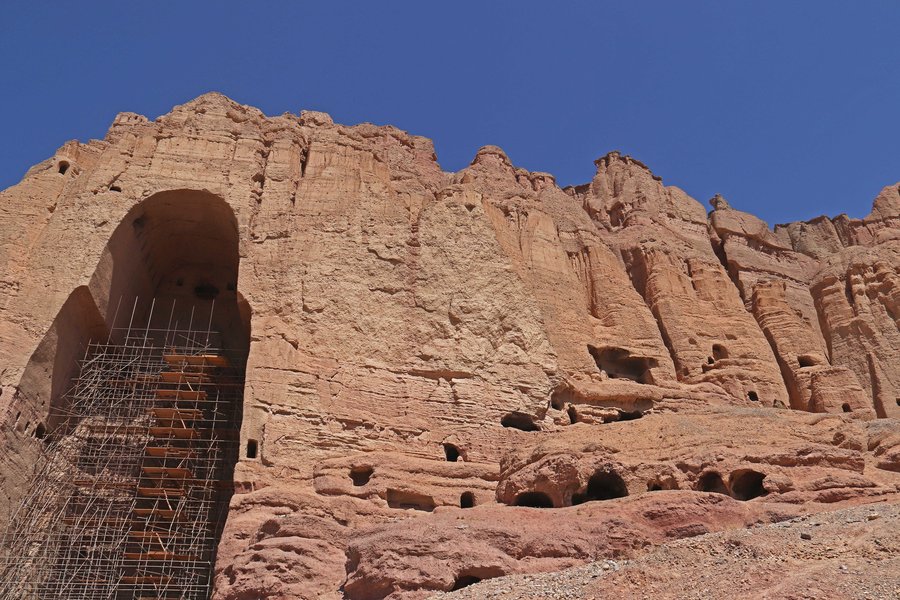
It was not exactly a day more like a 2 week experience in 1971. The most amazing place on my journey East. I had the good fortune to sit on the Giant Buddhas head and meditate and watch the sun rise over the Hindu Kush and watch those mountain peaks turn a color red that I had never seen in my life. The sunset on the buddha was just as spectacular. Lost to us forever by forces from hell. I also had the good fortune to ride horses over the fiords of Band I Amir lakes. I will never forget my trip to Bamiyan, I cried when I saw the destruction of the Buddha, I cried for all our loss but most of all for Hazra people who no longer have the magic of the Buddha. Sidney
Keep reading 0 comments
